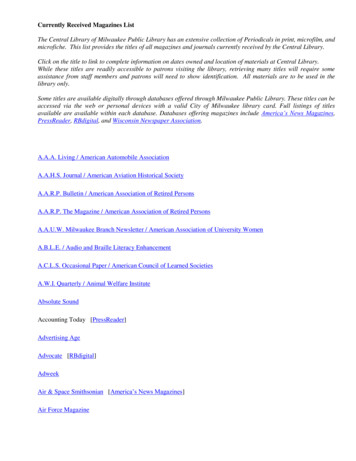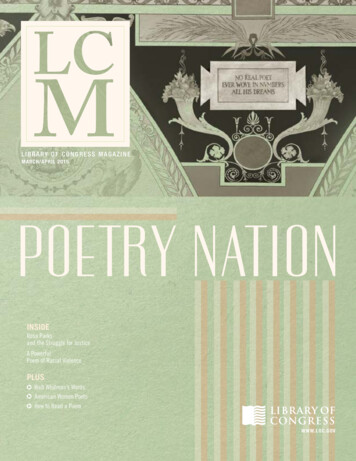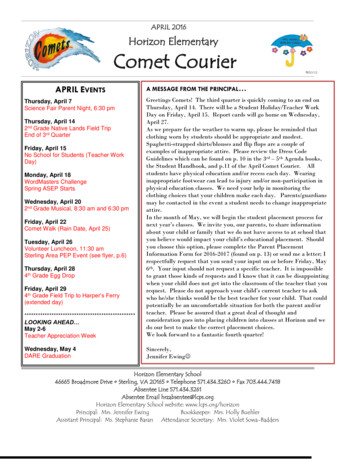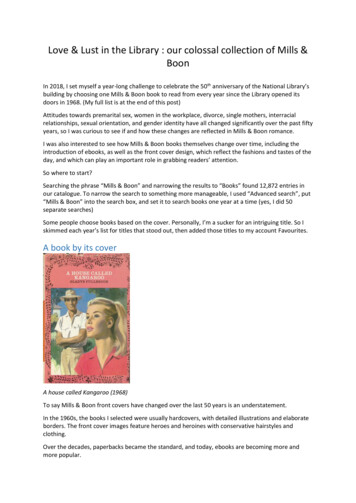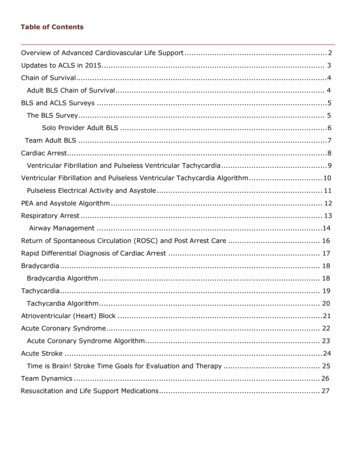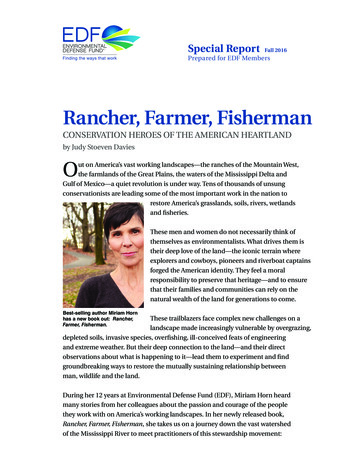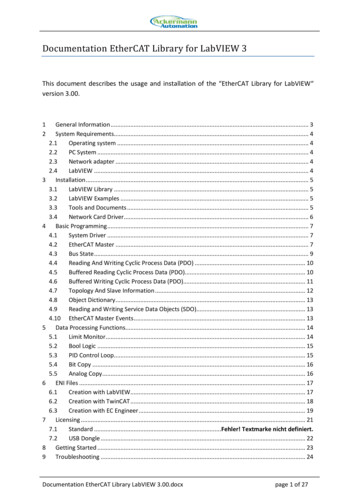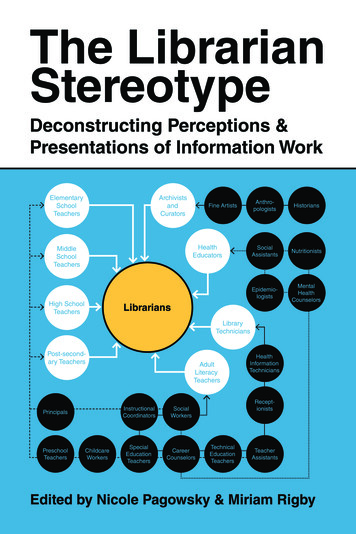
Transcription
The LibrarianStereotype:Deconstructing Perceptions andPresentations of Information WorkEdited byNicole Pagowsky and Miriam RigbyAssociation of College and Research LibrariesA division of the American Library AssociationChicago 2014
The paper used in this publication meets the minimum requirements ofAmerican National Standard for Information Sciences–Permanence of Paperfor Printed Library Materials, ANSI Z39.48-1992. Library of Congress Cataloging-in-Publication DataThe librarian stereotype : deconstructing perceptions and presentations ofinformation work / edited by Nicole Pagowsky and Miriam E. Rigby.page cmISBN 978-0-8389-8704-9 (pbk. : alk. paper) 1. Librarians--Public opinion.2. Librarians--Professional ethics. 3. Librarians--Psychology. 4. Library science--Public opinion. 5. Libraries and society--Public opinion. I. Pagowsky,Nicole. II. Rigby, Miriam E.Z682.L537 2014020.92--dc232014013675Copyright 2014 by The Association of College & Research Libraries, a division ofthe American Library Association.All rights reserved except those which may be granted by Sections 107 and 108 ofthe Copyright Revision Act of 1976.Printed in the United States of America.17 16 15 14 13 5 4 3 2 1Cover design by Dorothy Gambrell
Table of ContentsvAcknowledgementsviiForewordEmbracing the Melancholy: How the Author RenouncedMoloch and the Conga Line for Sweet Conversations on Paper,to the Air of “Second Hand Rose”James V. Carmichael Jr.1Chapter 1Contextualizing Ourselves: The Identity Politics of the LibrarianStereotypeNicole Pagowsky and Miriam Rigby39Chapter 2Academic Librarian Self-Image in Lore: How Shared StoriesConvey and Define our Sense of Professional IdentitySarah K. Steiner and Julie Jones63Chapter 3The Stereotype Stereotype: Our Obsession with LibrarianRepresentationGretchen Keer and Andrew Carlos85Chapter 4That’s Women’s Work: Pink-Collar Professions, Gender, andthe Librarian StereotypeAyanna Gaines131Chapter 5149Chapter 6From Sensuous to Sexy: The Librarian in Post-CensorshipPrint PornographyDavid D. SquiresRainbow Warriors: Stories of Archivist Activism and the QueerRecordTerry Baxter
ivThe Librarian Stereotype149Chapter 7Unpacking Identity: Racial, Ethnic, and Professional Identityand Academic Librarians of ColorIsabel Gonzalez-Smith, Juleah Swanson, and Azusa Tanaka175Chapter 8Librarians and Felines: A History of Defying the “Cat Lady”StereotypeDorothy Gambrell and Amanda Brennan185Chapter 9Between Barbarism and Civilization: Librarians, Tattoos, andSocial ImaginariesErin Pappas213Chapter 10At the Corner of Personality and Competencies: ExploringProfessional Personas for LibrariansLauren Pressley, Jenny Dale, and Lynda Kellam229Chapter 11Student Perceptions of Academic Librarians: The Influence ofPop Culture and Past ExperienceMelissa Langridge, Christine Riggi, and Allison Schultz257Chapter 12The Revolution Will Not Be Stereotyped: Changing Perceptionsthrough DiversityAnnie Pho and Turner Masland283Afterword289Author BiosToward a New Inclusion in Library WorkK. R. Roberto
AcknowledgementsThis project has been a truly collaborative effort, and without the contributions of many this book would not exist. We first extend thanks to ourauthors for writing compelling chapters and their dedication to taking revisions with grace. The topic of this book is expansive and at times ventures into risky territory, where authors needed to be bold in order to support their more critical points of view. We thank them for being outspokenand working to enact positive change in our profession.We also extend a heartfelt thanks to Kathryn Deiss for her guidanceand enthusiasm during this project. Kathryn has provided us with the perfect mix of mentoring, trust, and encouragement, and her support, alongwith the backing of ACRL Press, has helped us make this book exceptional.Both Emily Drabinski and Marie Radford have contributed wonderfuladvice for us novice editors, and we appreciate the time and thought theyput into answering our questions or making suggestions about processand approach.Dorothy Gambrell has been extremely generous in designing thebook’s cover and illustrating a chapter. Out of the kindness of her heart,and her fondness for libraries and librarians, she requested only a pricethat librarians could afford. We hope you will visit her artist sites for theCat & Girl comic (http://catandgirl.com) and her infographic-based project, Very Small Array (www.verysmallarray.com), and consider supportingan independent artist.We also greatly thank our peer-reviewers: Meghan Bean, JennyBenevento, Damon Campbell, Erica DeFrain, Laura DeLancey, EmilyDrabinski, Allie Flanary, Jenna Freedman, Lia Friedman, Aliqae Geraci,Leo Lo, Kelly McElroy, Erin Pappas, Sheila Rabun, John Russell, CassieSchmitt, Maura Seale, Yen Tran, and David Woken. Often in the conversation of research, these more invisible discussions go unnoted, but we thinkit is important to offer acknowledgement and thanks for the invaluableinsight shared along the way to the final product.v
viThe Librarian StereotypeLast but not least, we thank our friends and family for supporting us inthis process, as well as our institutions, the University of Arizona Librariesand the University of Oregon Libraries. And of course we want to say a bigthank you to all of the real-life librarians and other information professionals whose interest and participation in our presentations, webinars, andonline conversations motivated us to produce this book.
ForewordEmbracing the MelancholyHow the Author Renounced Moloch and theConga Line for Sweet Conversations on Paper,to the Air of “Second Hand Rose”James V. Carmichael Jr.This is the exalted melancholy of our fate that every Thouin our world must become an It.—Dag Hammarskjöld1What Stereotype?I grew up in a provincial and historic southern town without a publiclibrary but with an old social library established in 1893 that had beenturned over to the city to run.2 On my one visit as a small boy (my parentswere readers, and I had my hands full working through their library), Idiscovered a novel with a three-noun title, one of which was Mandolin. Theonly feature of the novel that sticks with me is the opening scene in whicha señorita peers through a keyhole at a matador who is undressing. Thelibrarian, who was the only other person besides my guardian and myselfin this rather largish one-story brick building with a domed skylight—inspired by the British Museum—checked the book out to me, but a weeklater at home, I received a private note from her on which she had carefullyplaced a bluebird sticker in the upper left-hand corner and had written inher impeccably neat script, “Dear Jimmy, I did not see the book you werevii
viiiThe Librarian Stereotypechecking out until after you left the building. Why don’t you bring that oneback and let me find one you would really like to read?” I did not give it upuntil it was due.Although this story predates the Broadway musical The Music Man, Ican state unequivocally that the play in no way exaggerates the puritanismof small-town American mores. At a jumble sale at the supposedly freewheeling Episcopal church (we were Presbyterians), a docent wanted torefuse to sell me a paperback entitled French Short Stories by de Maupassant and the other usual French fin de siècle literary suspects. The womankept pointing out the word French in the title to her coworker while raising her eyebrows provocatively as if the bodice-ripper cover art could notadequately convey its depravity. My guardian intervened, however, and Ireceived satisfaction for my dime.It is the librarian of the first anecdote I want to describe, however.She came from a locally renowned family, and her father was simply “thejudge.” She was a spinster in her 60s who stayed with her parents in theold home place supposedly to care for them although they could have justas easily been caring for her. They occupied a second-row pew in front ofmy family in church, and the librarian always plugged in her hearing aidbefore the sermon. At the library, she wore a gingham dress, rolled stockings, and—yes—tennis shoes. Her hair was braided around her head, andI picture her in a nimbus of flyaway strands and dust motes with her backto a window. She wore no makeup whatsoever, and her face was freckledwith age spots. It wasn’t until I was in library school 20-odd years later,voting for Jimmy Carter at that same library, that it occurred to me that Ihad grown up with the very paragon of librarians, an embodiment of thedespised stereotype, and that I had loved her almost as much as I loved myAunt Willie Mae, a woman of the same generation and ilk. During Halloween of 1963, while I was abroad at a French boarding school, the librarian had a breakdown brought on by the discovery that the assistant citymanager had been cashing the paychecks that she faithfully turned backover to the city because she did not need the public funds as much as thecity did. She died several years after the scandal. I never understood howanyone could deride a soul so selfless because I—an “old maid in britches”
FOREWORDixas Scarlett O’Hara might have called me—marveled at the librarian’s belief, indeed, faith, in her work. What need did she have for television orcommerce?I married one week out of college with a French degree. My wife andI were both weekend hippies, which made passing high-security clearancein the defense industry problematic, and I was soon laid off. I finally settledin trust administration in a now-defunct Atlanta bank for six years. Halfway through, my father died and my marriage, a re-creation of the relationsof the Montagues and the Capulets, finally sputtered out. It was harderand harder to hide disenchantment, and I was eventually terminated at mybank job, where I felt like the embodiment of inappropriate aptitude. Myvocational test showed me to be perfectly suited for the Catholic ministry,which must have derailed my father, who had arranged the test, at leasttemporarily. I unsuccessfully applied to the Navy: I aced their electronics exam—which worried me considerably because I can’t plug in a coffeepot without second-guessing myself—but did not pass the masculinity test (unwritten). I sat in the backyard one Sunday afternoon while mymother gazed worriedly out the window and wondered what I could dofor a living, besides converting to Catholicism and joining a monastery,that would not mortify her. I remembered visiting my sister and her husband at Duke University, where I was shown the Flowers Collection ofRare Books, and envying the assistant who was dusting and polishing thecovers of the leather-bound books. Maybe I could dust books. Thus, albeitunknowingly, I filled one of the worst stereotypes in the male librarian inventory: he who is a librarian because he’s failed at other work.3Little did I realize when I entered the master’s program at the Divisionof Librarianship at Emory University that St. Jerome was patron saint of librarians—the monastic ideal! Nor did I anticipate feeling for the first timeas if I had come home to a world I had left behind with my French degree:literature, philosophy, religion, art, dance, theater, film, music. Lunchesbecame interesting again. I no longer had to feign interest in football andbasketball scores or the latest stock-market wiz. I especially enjoyed thearduous hours trying to shake answers out of reference books for the multiple hard-knocks reference courses I took. I even enjoyed advanced cata-
xThe Librarian Stereotypeloging, during which our instructor devised a laboratory game where onedrew cards with various elements of MARC2 format (example: title 1card; space 1 card; semicolon 1 card; space 1 card) until one had acomplete catalog card.I accepted a job as a rare books cataloger in Milledgeville, Georgia—aperfectly preserved antebellum town that had served as the state capitaluntil 1868. It had escaped Sherman’s torch during the Civil War althoughperhaps all but one home was thoroughly emptied by the marauders.4 I actually never had a chance to catalog rare books because the regular cataloger moved back to Florida, and I learned OCLC copy cataloging in about aweek on the beehive dedicated terminal. Meanwhile, I allied myself witha gay group in Atlanta, and, in an attempt to quit smoking, I picked upneedlepoint. Soon I was inundated in pillows I had started as Christmasprojects, and as the library was always looking for an exhibit with which tostuff its cases, I soon mounted my projects, and the local paper ran a largecolor photograph of me in a three-piece suit lying amid my pillows likeBurt Reynolds in Playgirl, only fully clothed. I received one phone call athome from a vaguely threatening male voice that asked, “Don’t you thinkpeople are going to think you are kind of weird?” Not to be flummoxed,I cited Henry Fonda and Rosey Grier as paragons among male needlepointers. He hung up. Shortly thereafter, my new director suggested that Ineeded a doctorate to teach the reference course that I was then in my fifthyear of offering to school media specialists seeking certification. I wasn’tquite sure how to take that suggestion, but I applied to doctoral programsand kept hoping that someday I might meet the Nureyev-looking guy whoposed for the librarian photo in the 1982 Occupational Outlook Handbook.I did not, but who’s counting?Making an It of a ThouSkip a few years. I am a doctoral student, reading Garrison’s study of lateVictorian public librarians in America and focusing on Melvil Dewey’sfirst library school classes at Columbia and Albany, and stumble across thefact that those female “acolytes” who later left the profession for marriagefelt that they had betrayed “a sacred trust.”5 I don’t recognize these char-
FOREWORDxiacters because even at my most sentimental, I have always recognized thesteel grip behind the velvet gloves of the women I have known, includinga great-grandmother who was five years old when General Sherman camemarauding, a grandmother who taught Latin until she married in 1903,another grandmother who was a school principal, my mother who was aself-taught school librarian and a second-grade teacher until she marriedin 1938, and an ex-wife who read a science fiction novel while her weddingtrain was being arranged to march down the aisle: worthy opponents all.Garrison’s work confirmed that librarians’ cultural capital was passé:too many Protestant, white, sexually repressed librarians and far too manymale ministers (mainly) among their early leaders. I learned through a sociology of occupations course that I took with the eminent editor of SocialForces, Richard L. Simpson, that librarianship was a feminized semi-profession, one that had been occupied by men who then hired women to dothe busy work cheaply. In class, Simpson recanted the essay written withhis wife in 1969 just as militant feminism was forcing sociologists to revisetheir theories of power and professionalism.6Do librarians only come in vocational flavors? I certainly used to thinkso, much like Mrs. Delia Foreacre Sneed, later Lee (1868–1947), whoopined that reference librarians were “born” not “made” and describedreference skills as an “art.”7 Needless to say, the same artistic crown maybe granted to catalogers and not only those who share the OCD gene; infact, the present author could easily spend 1,500 at an office supply storeto get his life in alphabetical order in color-coded folders. Then he wouldbe sidelined for 15 years by the bon mots of various Bloomsbury writers ofthe 20th-century teens and twenties he would dream of incorporating intoa revised taxonomy of literary dysfunction: Non Sequiturs R Us.Managers must certainly be born, not made, although I imagine it isstill pedagogical heresy to say so since for the last 50 years or so, libraryeducation programs have been touting the value of managerial skills for all.People who succeed in rising to the top of big hierarchically organized academic libraries seem to practice the same low-affect tactics of control andmanipulation that Walmart managers do, whatever sex they happen to be.The only touchy-feely managers I’ve ever known worked in smaller private
xiiThe Librarian Stereotypeinstitutions. In public institutions, directors seem uniformly pained andself-involved, with the saving qualifier of a sense of humor in a minorityof cases. Then again, my experience with the upper echelons is extremelylimited and is tainted by my years working as a grunt in an aircraft factoryand a mainline southern bank to which I would drive from home at 5:30a.m. every morning to avoid the kind of rush-hour conga line I joined every afternoon in the desperate attempt to escape the city.I know that libraries are “just” businesses; however, after teachingacademic librarians and others for 25 years, I understand that they are (Iam?) fundamentally different personality types from the young people Iused to lunch with at the bank or sit next to in accounting and marketingclasses at Georgia State University (term paper: starting an astrology storein Underground Atlanta: C–). I no longer fear being considered quaintand unmanly in not bowing to the dictates of Moloch. In 2000, when theSupreme Court decided the presidential election and I could see the approaching nonstop round-the-clock coverage of another network sagaalong the lines of Joey Buttafuoco, O. J. Simpson, Tanya Harding, MichaelKennedy Smith, and Princess Diana, I snipped the cable and dumped mytelevision in the yard of an artist friend who makes sea creatures out ofscrap. I banned the computer to my workplace. My three cats were veryhappy, and I have never looked back.Back to my hometown librarian and the archetype fail-male librarian:the only sociological problem here is in my own head. There was a goldenmoment in my doctoral program that brought this fully to bear on my life.During those years, I stayed sane thanks to a recovery program, and as inall self-help organizations, there were some very intimidating and sociallycontrolling people who did not like nonconformists. One woman hadforbidden her followers to have anything to do with me because I wasn’tdoing things or behaving the way she thought I ought to. Asked to speakto a large assembly one night at which the woman and her acolytes wereperched on the edge of their seats, ready to pounce—the regular speakerhad failed to show up—I appeared in a 19th-century Alexander Hamiltoncostume in distressed green velvet: knee breeches, white stockings, longvest and coat with gold lace braid and brass buttons, tea-stained white lace
FOREWORDxiiijabot at my neck, and long lace cuffs draping out of my coat sleeves. I hadfound the outfit in an antique shop in Cameron, North Carolina, on my40th birthday after my mother had died. “All of what you see tonight,” Iexplained, “used to be on the inside of my head. Now it’s out here. I’vecome a long way, baby.” I spoke on for 45 minutes, completely at ease. Mynemesis could not intimidate me because the only nemesis I had to fearwas inside my own head.A similar experience happened a decade later at the 1998 IFLA conference in Amsterdam, where I had been asked to appear on a censorshipprogram to talk about homosexuality and libraries in the United States. Iwas on a double bill with the national librarian of Belgium, who was talkingabout the historical problems that had attended the language split betweenFlemish and French speakers in the country, similar to that of French andEnglish speakers in Quebec and Quebec separatism within AnglophoneCanada. I had travelled with my friend Deb White from Pittsboro, whohappened to also be my coiffeuse. We schmoozed well together and wereboth similarly disposed to bursts of southern irony amid the well-traveledcorridors of European tourism. “My God,” she had said when we arrivedin Reykjavik, “what is wrong with these people? They are beautiful people,but they are all dressed like they are going to a funeral. They need somecolor!” Both of us tried our best to supply that ingredient in abundancewherever we went. We could be heard from the top of glaciers—thosekinds of voices that carry because of regional inflection and emphasis andway too many cigarettes growing up.At any rate, when we arrived at the conference laden with bags fromthe Amsterdam street market filled with fabric, quilts, old furs, tassels,and bits of trim I was bringing home for a living room overhaul, wecame to the room where the speakers were to read their papers, all preprinted in conference proceedings; Wayne Wiegand, then teaching atthe University of Wisconsin, caught me outside the door. It was his encouragement that had led me to pursue the male librarian survey thatled to my 15 minutes of fame in the Library Journal for noticing thatthere were male librarians who had stereotype problems too, the mainone of which was the perception that male librarians might be gay.8
xivThe Librarian StereotypeMoreover, I had published the comments of the male librarians whorecounted being hit on by women or complained of having to clean upthe vomit in the lobby of their public library or do the heavy liftingbecause they were male, so a panel of distinguished female respondentsincluding Kathleen Heim de la Peña McCook, Suzanne Hildenbrand,and Dallas Shaffer commented on reverse sexism, etc., all in a very supportive and enthralling way.Wayne said, “Jim, you may not read your paper. I forbid you to dothat. They can read it in the proceedings. Just speak.” So when my turncame, after the Belgian librarian had delivered his paper word for wordin the finest old-world style, I bundled up with my bags; came to thepodium; introduced “My hairdresser, Debra;” and started unpacking thebags, describing our activity in the market that morning, and asking theaudience whether they thought that a fascination with fabric—fondlingand owning it, not producing it, or wearing a slightly ratty rabbit jacketwith just enough shoulder padding to look tailored but not like it wascut for Joan Crawford—was an indicator of male homosexuality becausethere was nothing in my personal life (other than being attracted to menand women in an affectionate but not necessarily sexual way) except mypassion for color and line, china, and a tendency to roll my eyes to giveme away: no lover, anyway. Maybe I would be like my friend Marthawho had talked me into readiness for the doctoral program. She usedto say that she was going to have all female pallbearers because no manhad ever taken her out while she was alive, and she was damned if onewas ever going to do it after she was dead. The room cracked up. We hada lively exchange aided by James Anderson of Rutgers, there in lieu offellow faculty member Pamela Spence Richards (1941–1999), also ofRutgers, who had solicited the paper and invited Anderson, along withhis partner, my friend Debra, and me to stay with her at her summerhome in Holland, only to be diagnosed with a brain tumor from whichshe never recovered.I’m not through with that story either. Pamela Spence Richards and Idiscovered, after I had known and revered her for years in the meetings ofthe Library History Round Table where she was the authority on Soviet-
FOREWORDxvera Russian libraries and information problems, that her mother and myfather had had an affairette in 1937. Her mother was a taxi dancer in Atlanta and he was in the state legislature fighting for railway rate reform.She presented herself as an actress rather than a dancer, and my father,ever the soul of Protestant rectitude, disparaged her lack of complete andtotal honesty. A good thing too, my mother might say, because she and myfather married in 1938.Librarianship is the vehicle through which all of these scenes andwardrobe changes occurred: coincidences that were not really coincidences—serendipity of the highest order. These miracles and the people whowere the medium for them came to me through the rich heritage of librarianship, which, like Christian Evangelism, does its best work while beingon the sidelines of social reform rather than the center of policy making,for example, in Congress. I understand that librarianship is a business, butthat is not all or even mainly what it is, and the same can be said for anyschool or university you care to name. For many people, the fact that allinstitutions are businesses first and services second is an indication of howfar astray capitalism has led us. After all, Carnegie, Rosenwald, Rockefeller, and others did not contribute to libraries and educational centers tomake them profit centers or bureaucratic structures whose primary purpose was to remain indestructible and perpetuate themselves; rather, theygave money to libraries, schools, universities, and museums because thoseentities were good for society.The post-9/11 American computer-generated dysphoria, so well described in Thomas Pynchon’s mordantly funny novel The Bleeding Edge(2013), is evident in the divisive spirit, social and economic inequality,and preposterous televised rhetoric by which a large portion of the citizenry of both political parties of the United States live. The United Statesseems to be caught in an exit-less maze of conundrums—medical, intellectual, ideological, and spiritual. These are not the kinds of problems thatcan always be solved by theory, formula, data, or assessment. We all knowtoo well the nature of the problems, if we know that there is a problem atall. Those who don’t know there is a crisis or at least a radical re-posturingof positions are living in what that crazy old drug-addled radical plutocrat
xviThe Librarian StereotypeWilliam S. Burroughs called The Soft Machine, lulled into complacency bythe blinking lights, the alienation, the comforting company of electronicmedia.9 In such a world, deep thought and deliberate statements and actions are called for and hopefully will be forthcoming, along with generous portions of humor. Libraries and the literature confirm one comforting truth that no politico or zealot wants to hear: humans are foolish; theyerr, but if they persevere, they can forgive themselves and each other andmove forward.Maybe there really are two kinds of human beings as one of my favorite students once proposed in a social sciences literature class: those whoare always looking forward for the main advantage and those melancholicsouls who look backwards and try to learn from their mistakes. As one observer of modern folly recently observed, breaking the cycle of relentlessand dehumanizing “progress”is about slowness, and about finding alternatives to alienationthat accompanies a sweater knitted by a machine in a sweatshop in a country you know nothing about, or jam made bya giant corporation that has terrible environmental and laborpractices and might be tied to the death of honeybees or thepoisoning of farmworkers. It’s an attempt to put the world backtogether again, in its materials but also its time and labor. It’sboth laughably small and heroically ambitious.10There is a balance, of course, just as there are far more types of human being than any one person or author can account for. Librarians can speak forall of those people whatever allegiance they claim and whatever wardrobethey wear—entrepreneurs, maiden aunts, accountants, lovers of bodicerippers, fanzine fashionistas, deconstruction divas, gay anorexics in designer hair shirts, exotic musky-voiced singers of the last known unknownlanguage in the world—or is this just nostalgie de la boue? Do we have to goback to caves and try it that way for a while until the bombs stop falling, asSabrina suggested in Thornton Wilder’s The Skin of Our Teeth? I choose tothink not. I think it is the very latest thing, and it is fit for very long-termwear.
FOREWORDxviiRevising My ThouFor a start, maybe I better quit buying and collecting and start sharing.Perhaps the profession needs to petition the new Pope Francis, whoseems to be a stellar person, to change the patron saint of librarians fromSt. Jerome, who was always rather cranky—a result of eating all thoselocusts with honey, no doubt—to Hypatia, the last great Greek philosopher, who was martyred by a Christian mob in Alexandria in 415 CE. Shesounds much more like the kind of saint we need in these troubled times.I will lengthen my list of correspondents to practice what is left of mypenmanship and sharpen my ability to express myself. In addition to dearVirginia in Lincoln, Nebraska, and dear Sandy in Milwaukee, Wisconsin, Iwill also occasionally write reflective letters to my two sisters so that everything we express won’t be trapped in the dynamics of dysfunction.I will learn how to breathe mindfully.I will claim ownership of my librarian wardrobe, not only what I wear,but what I own as part of me, what I value as a professional, and I will accept no professional truths as personal gospel unless I believe it is so. Myinside, vintage or not, should be as carefully nurtured as the external imageI project. That should keep me busy for a while.Notes1. Hammarskjöld’s translation of Martin Buber’s I and Thou from German, on which Hammarskjöld was working at the time his plane crashed in Nbola, Zambia, on September 18, 1961;quotation from Michael Ignatieff, “The Faith of a Hero,” review of Hammarskjöld: A Life, byRoger Lipsey, New York Review of Books 60, no. 17 (November 7, 2013), hammarskjold-faith-hero.2. Sadie T. Gober, The First Hundred Years, Georgia (Atlanta, GA: Walter W. Brown, 1935),433–37.3. Arnold P. Sable, “The Sexuality of the Library Profession: The Male and the Female Librarian,” Wilson Library Bulletin 43 (1969): 748–51.4. James C. Bonner, Milledgeville (Athens: University of Georgia Press, 1978), 190.5. Dee Garrison, Apostles of Culture (New York: Free Press, 1979), 176.6. Richard L. Simpson and Ida M. Simpson, “Women and Bureaucracy in the Semi-Professions,” i
Between Barbarism and Civilization: Librarians, Tattoos, and Social Imaginaries Erin Pappas ChApTer 10 At the Corner of Personality and Competencies: Exploring Professional Personas for Librarians Lauren Pressley, Jenny Dale, and Lynda Kellam ChApTer 11 Student Perceptions of Academic Librarians: The Influence of Pop Culture and Past Experience

